WWII German Navy Dagger history -
The German Navy, also known as the Kriegsmarine, saw its start from the remnants of the German Navy of
Kaiser Wilhelm II. After the conclusion of WWI, with the 1918 armistice the restrictions placed upon
the German Navy by the treaty of Versailles were so strict that the entire Imperial fleet was scuttled
in Scapa. The year was 1919.
This action presented germany with the opportunity to re-design the ships in the navy to accomodate to
the present restrictions. The designer, Bloem und Voss, was instrumental in developing the concept of the
"pocket battleship", which met the restriction of keeping the weight of each ship under 10,000 tons.
Within two years of Hitler gaining power, he concluded a treaty with Great Brittain which eliminated the
tonnage restrictions on the German ships. It is at this time that battleships such as the Bismarck and
the Tirpitz get the green light for design and construction.
The German navy adopted the use of a dagger for its officers back in 1842. The officers were
very traditional and did not follow the Nazi party line off the start. Hitler appointed Admiral Raeder to
command the Navy. He was very much in line with the nazi party. However, the Kriegsmarine was the last of the
armed services to dress their daggers with the swastika.
The anatomy of the German naval dagger is covered here:
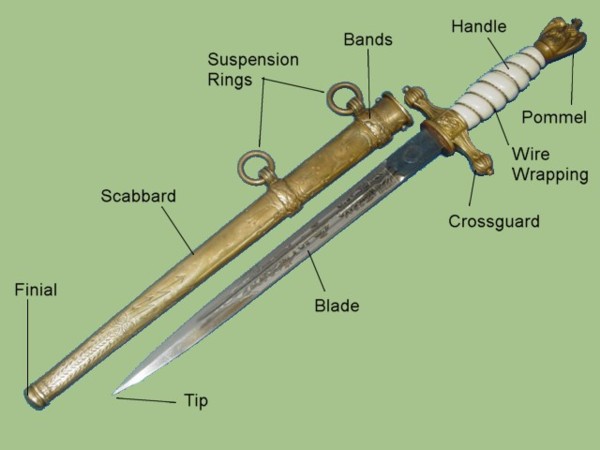
NAVY DAGGER MODEL I
The Navy First Model dagger was during WWI and
all the way until 1938. The design of the dagger consists of a metal pommel. The handle is made of cellulite,
which is an early version of plastic. Of swirled design. Wire wrapping is applied in the valleys formed by
the swirls.

The crossguard design consists of a rectangular center with extensions protruding to the left and right. An
anchor is placed in the middle of the rectangle. The extensions are capped with crown shape endings. The
reverse of the rectangle is blank. A spring loaded button is found in the lower section of the front of the
crossguard. It controls a lever that locks the dagger to the scabbard. caution must be exercised when
pulling the dagger out. make sure to press the button first or damage may occur to the mechanism.
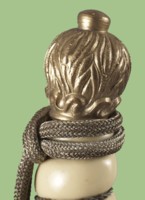 |
This the pommel for the First Model Kriegsmarine dagger. It was known as the "Flaming ball" due to its
design. It was employed from 1919 to 1938. After that the design of the Swastika was adopted, therefore
creating the Second Model dagger.
This device substituted the Hohenzollen Imperial crown.
Some daggers were complimented with the use of a portapee. This device consisted of silver cord forming a loop
and ending in a tightly bound knot. The portapee was wrapped around the pommel area and the crossguard.
Different lengths of the portapee can be found.
The scabbard is adorned with multiple dinples. This style is known as "hammered scabbard" and is usually associated
with administrative personnel.
|
The scabbard has two bands. one near the throat, the other closer to the mid-body. A suspension ring is attached
to each band. The finial is rounded. Often times this part is dented because during normal use the dagger may have
been dropped, exposing this part to the full impact.
NAVY DAGGER MODEL II
The design of the Navy Second Model dagger was
very similar to that employed in the First model. The primary differences were found in the pommel and
the crossguard.

The handle was of white cellulite. Swirled design with wire wrapping applied to the valleys formed by the
pattern. The wire was usually a single silver strand. the crossguard has the square center with branches
extending to the left and right. a release button controlled the locking mechanism which engaged once
the dagger was placed inside the scabbatd.
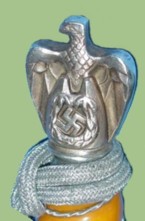 |
This the pommel for the Second Model Kriegsmarine dagger. This design was adopted in 1938. It eliminated the
falming ball pattern. The design consisted of an eagle with retracted wings, the head facing to the left.
Feathering pattern reflected on the chest. Some plumeage defined on the wings. The eagle is clutching
a wreat with a swastika in the center.
The scabbard is decorated with a series of linera patterns executed in four different sections. Both front
and back are covered with these decorations. A band is placed near the throat area and the mid-body. A
suspension ring is attached to each band.
The finial of the scabbard is often flattened, just as shown in this example. This condition is caused by
the dagger being accidentally dropped on the ground.
All the parts of the dagger were made of brass with the exception of the blade. This construction held up better
to the rigors of the open sea.
|
The blade consisted of a double edge, stilleto style, bearing the manufacturer's logo on one side. The blade was
also decorated with a series of etchings of leaf patterns on both sides of the blade.

DAGGER HANGERS
The hanging straps used to suspend the Kriegsmarine dagger were basically the same between the Model I and
Model II daggers.
One thing that should be noted with the hanging straps of the Third Reich is that the ones used by the administration
officers who wore the standard dagger but had silver or alluminum fittings in their hangers.
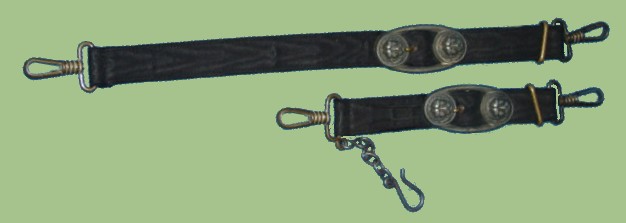
Here is a view of the back of the Navy dagger hangers.
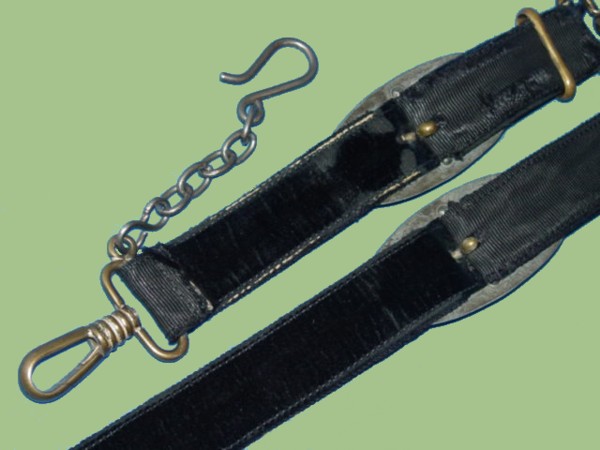
The following is a list of some of the companies that manufactured the Navy dagger during WWII.
| Count |
Number |
Company |
Description |
Logo |
Comments |
| 1 |
1 |
Eickhorn |
Squirrel holding sword |
n/a |
n/a |
| 2 |
2 |
WKC |
Knights head |
n/a |
n/a |
| 3 |
3 |
Holler |
Thermometer |
n/a |
n/a |
| 4 |
4 |
Horster |
Sword pircing initials HHS |
n/a |
n/a |
| 5 |
5 |
Alcoso |
Scales |
 |
n/a |
| 6 |
6 |
Wayersberg |
Sword in wreath |
n/a |
n/a |
| 7 |
7 |
Puma |
Puma head inside a diamond |
n/a |
n/a |
| 8 |
8 |
Adolf Brown |
Name alone |
n/a |
n/a |
| 9 |
9 |
Clem and Jung |
Letter "Z" in crowned shield |
n/a |
n/a |
| 10 |
10 |
P.D. Luneschloss |
Sword piercing helmet |
n/a |
n/a |
| 11 |
11 |
Tiger |
Tiger |
n/a |
n/a |
| 12 |
12 |
Anton Wingen |
Little knight |
n/a |
n/a |
| 13 |
13 |
Voos |
Snake around stump |
n/a |
n/a |
| 14 |
14 |
E. Pack and Sohn |
Sigfried with hammer |
n/a |
n/a |
| 15 |
15 |
Carl Julius krebs |
Lobster in shield |
n/a |
n/a |
| 16 |
16 |
SMF |
Seated king |
n/a |
n/a |
| 17 |
17 |
Klaas |
Kissing cranes |
n/a |
n/a |
| WWII GERMAN NAVY DAGGER EXAMPLES |
As discussed earlier, the Navy daggers were produced by various manufacturers. The following is a list of examples of
different German Navy officer daggers. It is a good idea for the collector to review as many examples as possible as
this experience helps identify the real daggers from the reproductions.
This information is brought to you courtesy of MilitaryItems.com. The premiere provider of military
collectibles to musuems, educational institutions and the general enthusiast.
|







